The House of the Rising Sun chords
by The AnimalsSong Key: A Minor (Relative to C Major)
Time Signature: 4/4 or 12/8 or 6/8
Tempo: 78 - 82 bpm (♩.)
Guitar Tuning: E A D G B e
Skill Level: Beginner
Guitar Chords: Am, C, D, F, E7
There has been some controversy over the song key as it uses chords from different scales. You may be interested in the following information... (see below)
Play-Along Video & Chord Charts



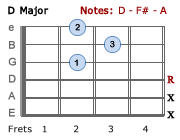
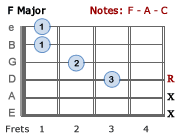
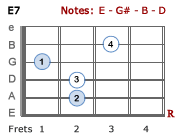


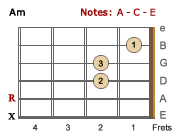


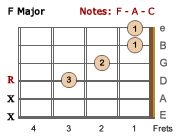


House Of The Rising Sun
The Relative Major Key of Am is highlighted - Transpose to any other key.
Am C D F Am E7 Am E7
Intro: 6/8 ‖ | | | | | | | ‖
Am C D F Am C E7
1. There is a house in New Or-leans They call the Ri-sing Sun | 𝄎 |
Am C D F Am E7 Am
And it’s been the ruin of ma-ny a poor boy And God I know I’m one
Am C D F Am E7 Am E7
Instr: ‖ (one) | | | | | | | ‖
Am C D F Am C E7
2. My mo-ther was a tail-or | | Sewed my new blue jeans | 𝄎 |
Am C D F Am E7 Am
My fa-ther was a gam-blin’ man Down in New Or-leans
Am C D F Am E7 Am E7
Instr: ‖ (-leans)| | | | | | | ‖
Am C D F Am C E7
3. Now the on-ly thing a gam-bler needs Is a suit-case and trunk | 𝄎 |
Am C D F Am E7 Am
And the on-ly time he’s sat-is-fied Is when he’s on a drunk
Am C D F Am E7 Am E7
Instr: | (drunk)| | | | | | | |
Am C D F Am C E7
| | | | | | | | 𝄎 |
Am C D F Am E7
| | | | | | |
Am C D F Am E7 Am E7
| | | | | | | | |
Am C D F Am C E7
4. Oh mo-ther tell your chil-dren | | Not to do what I have done | 𝄎 |
Am C D F Am E7 Am
Spend your lives in sin and mi-se-ry In the House of the Ris-ing Sun
Am C D F Am E7 Am E7
Instr: ‖ (sun) | | | | | | | ‖
Am C D F Am C E7
5. Well I got one foot on the plat-form | | The o-ther foot on the train | 𝄎 |
Am C D F Am E7 Am
I’m goin’ back to New Or-leans To wear that ball and chain
Am C D F Am E7 Am E7
Instr: ‖(chain) | | | | | | | (Well there) ‖
Am C D F Am C E7
6. Well there is a house in New Or-leans They call the Ri-sing Sun | 𝄎 |
Am C D F Am E7 Am
And it’s been the ruin of ma-ny a poor boy And God I know I’m one
Am C D F Am E7 Am E7
Instr: ‖ (one) | | | | | | | ‖
Am/addG
Am C D F Am E7 Am E7 Am
‖ | | | | | | | | 𝄑 ‖
Notes and Useful Tips:
- Level Of Ease: Easy - the timing is a little tricky at first but you get used to it pretty quickly once you get the hang of it.
- Key Signature:A minor, although it does share chords with other keys. For anyone that may be interested, here's a little excerpt I found in a forum at guitar-music-theory.com. It is written by Desi Serna, a noted & respected author on guitar theory. It helps to clear up some confusion relating to the key signature of this song.
The guitar chord progression to "House of the Rising Sun" by The Animals includes chords from more than one scale.The Am, C and F all fit into the C major scale (A Natural Minor or Aeolian Mode).
The D chord requires an F# note. This could be thought of as stemming from the G major scale (A Dorian Mode - A B C D F# G) or A Melodic Minor scale (A B C D E F# G#).
The E7 requires a G# note. This changes the scale to A Harmonic Minor (A B C D E F G#) or A Melodic Minor scale (A B C D E F# G#)..
As you can see, this song is a bit complex when you break it down. It's actually a combination of keys. You could call this using "borrowed chords" because you're borrowing from other keys, or "modal interchange" because you're interchanging different modes. I don't think the writers had this intention. They probably just combined the chords by ear rather than considering the theory. If you want to play lead guitar over this, then you'll have to either switch scales when the chord requires it, or just think A minor (C major) the whole time and avoid the notes that clash. Another option is to play A minor pentatonic over the whole thing. Try it!— Desi Serna
- Here is one of the popular patterns for the Am pentatonic scale

- Time Signature: 4/4 or 12/8 or 6/8... consider the following:
- If you use the 4/4 time signature, each beat of the bar is treated as 4 x eighth-note triplets (a group of three notes is played in the same time as 2 notes of the same kind OR three evenly spaced notes played in one beat). Therefore a bar which you may normally count as | 1 2 3 4 | OR | 1& 2& 3& 4& | would now be counted as | 1&& 2&& 3&& 4&& | etc. with chord changes generally occurring on the 1st and 3rd beats of each bar... the following chart shows you a sample of the timing in triplet segments... the count includes rests which are actually the bass notes in the bass clef - written for piano.
Please Note: The chart represents 'common time', written as 4/4 (4 quarter-notes per bar) which is discussed here to show each set of triplets clearly as 1 beat.

- This could also be given a key signature of 12/8 which would look like this - written for guitar. There are 12 eighth-note beats per bar. This can still be counted as above with 12 segments per bar.

- If you use the 6/8 time signature, there are 6 eighth-note beats per bar and each bar count is simply | 1 2 3 4 5 6 | etc. with chord changes occurring on the first beat of each bar... it would look exactly like the 12/8 time above except that each bar is halved with a chord change for each bar.

We have used the 6/8 time in our song sheet for simplicity with 1 chord change per bar. - Tempo: ~ 82 bpm
- Using a Metronome or click track:
At 4/4 the sound will occur on every beat 1 2 3 4
At 6/8 the sound will occur on every 3rd beat 1 2 3 4 5 6 - (1 chord change per bar)
At 12/8 the sound will occur on every 3rd beat 1 2 3 4 5 6 7 8 9 10 11 12 - (2 chord changes per bar) - The 𝄐 fermata / pause symbol - the last chord of the song is strummed and held till it rings out.
Song Details:
- Songwriter: Traditional
- Arranged by: Alan Price from the band, The Animals.
- Lyrics Begin: There is a house in New Oleans, they call the Rising Sun,
- Performing Artists: The Animals
- Single:
Recorded: May 18, 1964
Released: June 19, 1964
B-side: Talkin' 'bout You - Genre: Folk rock, blues rock
- Album: The Animals
Recorded: 22 January – 31 July 1964
Released: September 1964
